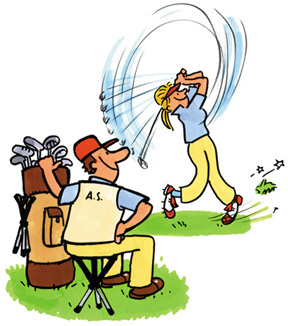Thoughts On The Golf Swing
By Tom Abts
I just finished reading Brandel Chamblee’s new book “The Anatomy of Greatness” – the subtitle is “Lessons from the Best Golf Swings in History.”
My first thought after reading the subtitle was, “Is what works for the best players necessary for recreational golfers?” I believe that there are definitely golf swing fundamentals for all golfers – world champions and average players. But, are the swings of the all-time best players relevant for every player?
I think we can all learn from the swings of great players, but it has to be put in perspective. What makes them great, might not be necessary to be good. And to be great is probably unrealistic for most players.
I’m on a few golf swing message boards that get pretty heated. There are guys who believe wholeheartedly in the robotic model of the golf swing. They believe that not only is it the correct swing, but that it is the only valid swing. They think anything else is just plain wrong. And they think that instructors who individualize their teaching are just allowing anything.
Sounds pretty rigid to me. Obviously not “anything goes,” but what about dealing with the differences in people? I think the issue goes back to fundamentals. I think there are certain fundamentals to a good golf swing, and it is the instructor’s job to find ways to get a variety of people to understand and do the fundamentals.
But maybe that’s because I’m a priorities guy. I’m always ranking what I need to do as A’s, B’s, and C’s. And I’m not great with the C’s – I have limited time. Yet, some people think that if I don’t do the C’s that I must really mess-up the A’s. Not really – actually it’s the opposite. And too many people take the A’s for granted. That’s where the term micro-management comes from.
Here’s a golf swing example. About twenty years ago, a serious, middle-aged woman came into the pro shop and demanded that someone look at her swing. I volunteered, and on the way to the range asked her what was going on. It seems that she’d been elevated to VP in her company and needed to play decent golf. So she went to an expensive golf camp in Arizona for ten days. She’d come back home and couldn’t hit the ball – she was really upset. So I asked her to hit an 8 iron at the 100 yard flag. After going through the longest process of setting-up to hit a golf ball I’d ever seen, she then made her “perfect” swing and topped the ball about 10 feet. She did it two more times – each set-up was about five minutes long – with the same 10 foot topped shot.
My story doesn’t end there. She was mad when she walked into the shop – now she was furious. So I said, “You seem to believe that the golf swing is a checklist and that if you get all of the steps checked that you will hit a perfect shot. And that if the shot isn’t good, we just need to go through the list to find the problem”. She replied, “Of course.” Then I said that her hands didn’t know where the center of the clubface was. And she said that she didn’t know what I meant. So I took her 8 iron and lined up to the ball standing sideways facing the range with my body, and asked what they would say about this set-up at her golf school – she said that it was all wrong. So I then proceeded to hit the ball close to the 150 marker. She yelled, “That was a trick shot!” I then replied that it didn’t matter, that what mattered was that I could hit a good shot from any stance because my hands knew where the clubface is.
That is the bottom line for most golfers. Can they get the clubface squarely on the ball? Nothing matters until that is happening. The stance, posture, shoulder turn, weight shift, etc. doesn’t matter if the hands can’t control the golf club.
It’s much like throwing a ball. A shortstop can throw off balance and side-arm accurately to first base. A catcher can throw down to second without standing up. A pitcher uses a windup to help him throw the ball. But a pitcher can throw about as well out of the stretch as using a windup. The body motion doesn’t throw the ball – the arm, hand, and wrist throw the ball.
Same with the golf swing. The body doesn’t swing the club. And proper alignment doesn’t necessarily direct an accurate shot – it helps, but the control of the shot comes from the control of the clubface by the hands.
Think of the golf swing as a pitcher’s windup – it gives you a nice motion to swing the club, but you hit the ball with your hands.
Chamblee’s book about great golf swings is comparable to looking at a book about great pitching windups. But the reason these players made the TOUR or the Major Leagues wasn’t because of their body motions… it was because of their arm and hand action.






























